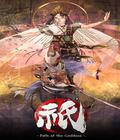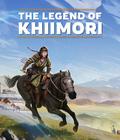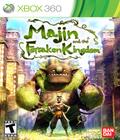Every year, publishers hype up their big games, and every year, both consumers and critics try to go through them. Just like movies, some of the games are completely undeserving of the attention; others fulfill expectations, and a select few go beyond that. While critics appreciate a good game, we appreciate sleeper hits even more. These usually turn out to be very well done but have relied on little to no hype. Darksiders is a good, recent example of such a title; very little advertising was devoted to it, and it was released at around the same time as the much more publicized Bayonetta. Despite these obstacles, enough people discovered Darksiders to transform what could have been a one-off game into a potential franchise. This season, the sleeper hit could very easily be Majin and the Forsaken Kingdom, the latest game from Game Republic, a developer best known for the Genji series and Folklore on the PS3.
The plot may not be original, but that doesn't mean that it isn't interesting. Over 100 years ago, an ancient kingdom was peaceful and prosperous with everyone working for the common good of man through their policies and inventions. Suddenly and without warning, the Darkness spread. A black sludge-like substance, the Darkness engulfed the kingdom, transforming the people and creatures into its minions and killing those who would stand against it. With the humans bickering for the remaining free land and resources, a young, nameless thief sets off to obtain the power of the Majin, an ancient beast of lore that has the power to defeat the Darkness and free the land.
You play as the thief who, despite starting out with no name, is later known as Tepeu. As his frame suggests, he isn't exactly the toughest fighter, but he is acrobatic enough to jump from high distances and traverse some small areas. His strength comes with sneaking, which is how you'll dispatch most of your enemies. Aside from being able to go through areas undamaged, it also turns multi-hit battles into one-hit encounters. Tepeu isn't strong enough to actually kill enemies, though; at most, he can knock out enemies that he encounters. This is where the Majin comes in.
Initially, the Majin known as Teotl isn't up to his full strength. He has the ability to push large objects, lift heavy doors, and kill the Darkness' minions, but that's about it. After some time with Tepeu, you can power him up with some elemental attacks that are not only good for killing the minions but also solving some of the puzzles in the game. Purification rids the area of enemies and clears out paths blocked by thick shadows. Wind blows away objects and stuns enemies in the path. Lightning sends electricity toward machines to activate lifts and open doors. Fire allows Teotl to burn objects and take away fire from the selected area.
Although familiar, the story really holds together the game. Finding icons that represent fragments of Teotl's memory open up the backstory to reveal that he had failed to protect his friend and stop the Darkness from spreading. Teotl's demeanor changes upon remembering those incidents, and that fleshes him out as a character and gives him more personality than the strong simpleton that you initially encounter. The bosses also contribute heavily to the story, especially when you defeat them and hear their backstory. You start to feel sorry for these souls as you realize that death was their only option. The story mechanic is similar to the one used in Metal Gear Solid 4, though the difference is that it never feels like they're hammering home the fact that they were all helpless and tortured souls.
A good amount of time is spent in three different areas, each with a few strengths and weaknesses. The moment you get out of the castle where Teotl is being held, you'll discover a vast wilderness of areas with puzzles and enemies; they need to be defeated if you're to reach the heart of the castle and defeat the Darkness. The level layouts are similar to a Legend of Zelda or Metroid game in that you'll stumble across areas that are inaccessible until you help the Majin obtain a new power that solves the puzzle blocking your path. As always in these types of games, there is a fair amount of backtracking, but luckily, it's pretty easy to deal with because the loading screens pass by rather quickly. On the other hand, since Tepeu can't permanently kill any of the minions, areas are re-populated with enemies when you revisit, so you're forced to go through the process of disabling them again in order to traverse the area. The alternative would be to simply run through the area, but there are a few areas where it's almost impossible to do that, either.
Puzzles make up a good chunk of gameplay in Majin and the Forsaken Kingdom. The good news is that the puzzles are pretty easy to solve, and their solutions are quite obvious when you see the obstacle. One refreshing thing is that the puzzles are often integrated into boss fights, forcing you to use some smarts since mindless bashing does nothing in many fights. Despite their simplicity, you never feel like you're encountering a puzzle for the sake of having a puzzle impede your progress. Now that's some good game design.
Combat makes up the last portion of the game, and depending on your outlook, it can be both brilliant and disappointing. Teotl's AI acts brilliantly in combat. You have to command him to perform actions like opening doors and crouching outside of combat, but during combat, he automatically goes for the most threatening enemy and hurts foes in his vicinity. His knockdowns are often openings for Tepeu to throw in a few extra hits and initiate stronger co-op moves on enemies. He's smart enough to go for the weak spot on bosses and to immediately heal or resurrect you should you fall in battle, so he's more useful in combat than most AI companions. When you do control his attack actions, it's usually for trap moves, such as signaling when he should push over walls and large boulders to destroy enemies.
Once you don't have access to Teotl, combat immediately turns toward sneaking kills, which work fine for Tepeu. Getting spotted makes it much tougher for Tepeu to disable enemies, and it is more of a chore in the long run. While you get more attacks as you and Teotl perform more combination attacks, the upgrades are related to combination attacks and don't feel very different from the plain combination attacks.
Costume pieces that you acquire throughout the journey are a nice visual change, but they're ultimately beguiling since their promised upgrades aren't particularly noticeable. The armor pieces promise an increase in acrobatics, but you don't jump higher or perform tricks that you were unable to do before. Any leveling you do for Tepeu is restricted to stamina increases instead of fighting upgrades, so you're stuck with the same attack combos from the beginning of the game to the end. It'll be disappointing to those who are used to having their characters' move sets expanded as they progress.
One gripe that can be levied against the general gameplay is the level of difficulty. The default level of difficulty is fine, and the lengthy journey, which clocks in at over 10 hours, provides some good value in comparison to other, more expensive titles that offer less gameplay time. The complaint is that there isn't another difficulty level. You can try to go through the game again to retrieve the chests and memory fragments that you missed before, but without a method to make it more difficult the second time through, those who are looking for more of a challenge will be saddened to learn that they can't tweak the difficulty if they desire.
The graphics are very well done in Majin and the Forsaken Kingdom, though not exactly perfect. With the exception of his large eyes and long scarf, there's nothing really significant about Tepeu. He animates well enough, as does every other creature in the title, and the model looks fine, but there isn't anything that makes him memorable. The opposite can be said about Teotl. His hulking frame might be reminiscent of other creatures in other games, but his smile and patches of vegetation on his body make him stand out. The various Darkness enemies, from the minions to the bosses, also look good. Though they are reminiscent of similar creatures from other games, their constantly flowing ooze makes them a sight to behold, and their destruction, usually represented by splats on the ground, looks fine.
The environments start off dark and dank because you're stuck in the castle, but once you escape, you'll find some nice scenery with plenty of color and vegetation. The lighting is excellent and includes a day and night cycle that blends in well with the environment, especially when you consider that there are only a brief few load times when you enter new areas, and those are usually disguised with cut scenes. If there is one thing to pick on with the graphics, it would be the frequent pop-up of elements, such as grass and small bushes, as you walk through expansive environments. It only seems to occur during long stretches; any areas with bends hide the effect well, but that really is the only real blemish in the graphical package.
The sound doesn't fare as well as the graphics, and it is ultimately the weakest part of Majin and the Forsaken Kingdom. The music and sound effects aren't the issue, though. The music sways from both light-hearted fare to something belonging to an epic movie, and the transition is smooth. The score fits the situation well, and there's never a moment when you feel that the score is simply wrong for the scenario. The sound effects are also strong, with everything coming out crisp and booming through the speakers.
The issue with the sound is solely in the voices, specifically for the animal helpers. Teotl always speaks in a deep voice with broken sentences, and while some will be annoyed with the speech pattern, it'll be endearing to others, especially when he celebrates little triumphs, such as defeating a small batch of enemies or opening a large door. The generals sound menacing, though they sometimes go over the top during their speeches to the heroes.
Tepeu doesn't sound too special, but his overall performance isn't too bad. Once you start hearing the voices of your animal friends, though, things quickly go south. The first rat you meet sounds almost exactly like Tepeu, and unless you look at Tepeu's lips when he speaks, you'll think the voice belongs to his inner monologue. Other animals have voices that are grating, evoke too little emotion, or evoking too much emotion at the wrong times. After hearing a few of them, you'll wish there were fewer situations when you'd need to speak to them during the journey.
The game controls rather well, and though it uses just about every button on the controller, it never feels cumbersome. All of Teotl's commands are handled by pulling on the right trigger and selecting any of the face buttons or bumpers shown on-screen. Alternatively, the elemental attacks can be done by holding the right bumper and hitting any of the displayed face buttons. Pulling on the left trigger initiates sneaking and ducking, while your other face buttons handle the usual assortment of jumping and attacking options. The controls are responsive, so there's no worry of hitting a button and not getting feedback until much later.
There are a few issues with the control scheme, though. Using your staff to go up a ledge is difficult at first because you have to hit the X button to initiate the climb instead of the A button, as you normally would in other games. The sprinting feature will likely never get used because it doesn't feel like your normal walking speed and running speed are any different; as a result, the option feels tacked on instead of useful. It also becomes difficult to target the object with which Teotl will be interacting if there are multiple items in the vicinity. This issue is highlighted in the arachnid-like boss fight, where you'll target the boss most of the time instead of the chandelier on which you want Teotl to use his wind power. Thankfully, issues like this don't occur often enough, so the controls are usually a joy.
Majin and the Forsaken Kingdom is certainly worth playing. The quest is rather lengthy, especially given today's standards of single-player game length, and it remains enjoyable in both combat and exploration despite the occasional instances of backtracking. With the exception of the sound, the game is done well from a technical standpoint, and its use of color really makes it stand out among this generation of games. Despite the plethora of great games available this season, if you love adventure titles, try to find some time for Majin. While you might not like what you hear, you'll certainly enjoy everything else.
Score: 8.0/10
More articles about Majin and the Forsaken Kingdom











 Majin and the Forsaken Kingdom is a riveting action-adventure game featuring an engaging storyline of enduring friendship that takes players through a seamless world where an agile protagonist and a powerful AI- controlled monster must forge an alliance to battle enemies, solve puzzles and conquer challenges.
Majin and the Forsaken Kingdom is a riveting action-adventure game featuring an engaging storyline of enduring friendship that takes players through a seamless world where an agile protagonist and a powerful AI- controlled monster must forge an alliance to battle enemies, solve puzzles and conquer challenges.






































